- Article explains the meaning and significance of Kirtikukha in Indian temples. They are found in Hindu and Jain temples, in Bodh Gaya Temple too.
One of the most intriguing and a common feature among the
Hindu temple adornments is the Face of Glory or Kirtimukha. The half human -
half animal face, swollen with the intake of breath, is most prominently seen
on the sukhanasa, in the centre of the arches of littles niches or shrines, the
apex of windows, in front of the threshold of the garbhagriha on either side of
the lotus stalk in the centre, on cornices, pillars, and also walls. Kirtimukha
is also frequently seen in a row on the temple bases or socle, and is termed as
Grasa-pattika (Gujarat) and Rahurmukhamala
(eastern India). In south Indian temples it is seen on two sides of the steps
at the base of the temple.
Thus, this face of glory with its dark grin is seen looking
out from both the apex and base points of temples.

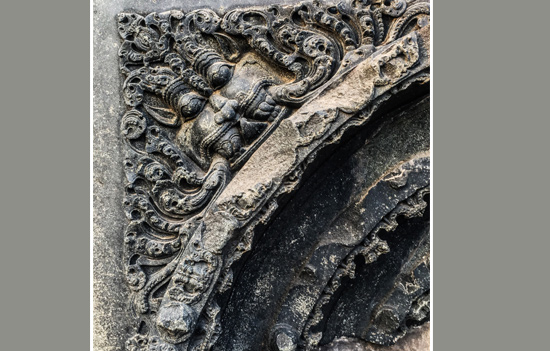 Kirtimukha. Warangal fort ruins of Sri Swambhu temple.
Kirtimukha. Warangal fort ruins of Sri Swambhu temple.
Full caption 2 - Kirtimukha.
Warangal fort ruins of Sri Swambhu temple from the Kakatiya era. The kirtimukha
seen here would have once been a part of the temple ceiling embellishments.
Kirtimukha has its equivalents in the Chinese T’ao T’ieh known from around 1st
millennium BCE; and in the medieval European architecture where it is seen
in the Notre Dame, and in English churches where it is often known as the Green
Man.
What is kirtimukha and what does it look like
The kirtimukha most often has the face of a lion
and is also known as simha mukha or the lion faced. It has two horns, with a
third or middle horn in the forehead centre, just above the two bulging eye globes
that protrude out of their deep sockets. The entire face with its carvings
gives the impression of deep inspiration through the nostrils, and the breath
restrained between inspiration and expiration across the bridge below the eyes
and over nose.
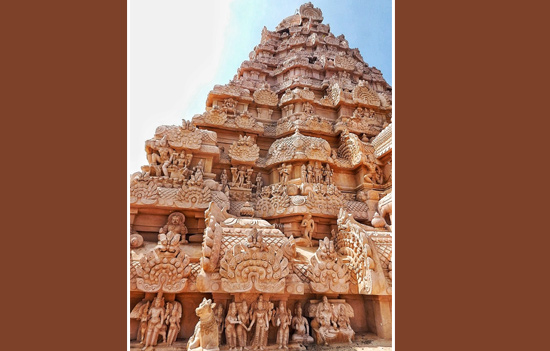 Rahu’s head or kirtimukha. Brihadeswara Mandir, Tanjore.
Rahu’s head or kirtimukha. Brihadeswara Mandir, Tanjore.
Rahu’s head or kirtimukha is seen in the apexes of
the tall gopurams, and repeated on gavaksha emblems throughout the temple
superstructure, on the bhumis, and cornices of south Indian temples where it is
depicted in its full meaning, as the Head, and Prakriti in the arch below it.
Seen here are many kirtimukhas in the apexes of the gavakshas on a Gopuram of
the Brihadeswara Peruvudaiyer temple in Tanjore.
 Kirtimukas in bands known as Grasapatti or Rahurmukhamala as moulding embellishments.
Kirtimukas in bands known as Grasapatti or Rahurmukhamala as moulding embellishments.
While kirtimukhas were present in Indian art and iconography
from the times of classical antiquity (beginning of Common Era or perhaps even
before that, as for example horned kirtimukhas from Sirkap in Taxila), its most
developed form is seen from 10th century onwards when it became a fixture on
the sukhanasa gavaksa.
If observed closely it will be seen that the kirtimukha is an
incomplete face with no lower jaw, and from below its protruding teeth emerge
the arch of the gavaksha and the other forms seen around it. The entire arch
formed around or below the kirtimukha is often filled with ganas and other airy
forms seen flying towards the centre of the archivolt, where in Odisha temples
we find a bell hanging.
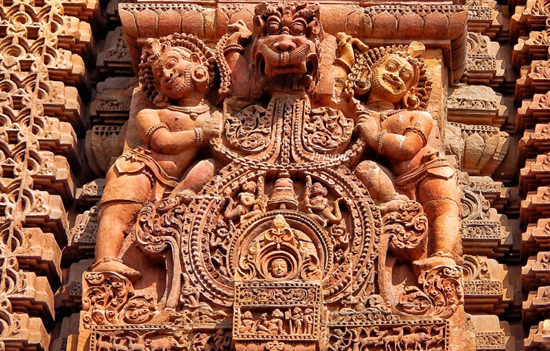 Kirtumukha on the sukhanasa gavaksa, where a
bell hangs from the centre of the archivolt. Mukteswar temple, Bhubaneshwar.
Kirtumukha on the sukhanasa gavaksa, where a
bell hangs from the centre of the archivolt. Mukteswar temple, Bhubaneshwar.
The outside edge of the gavaksha arch is filled with curvy
carvings denoting foams, waves, and wings. All these are an extension of the
makaras that lie at the arch base forming the two ends; and often these makaras
are seen protruding from beneath the puffed up cheeks of the kirtimukha. When
makaras form the base ends, the kirtmukha is known as Kala-makara.
The inner circle of the gavaksha is open and in the lower
part is generally is seen an aspect of the main deity of the temple, or it has
a lotus in it, and this lotus corresponds to the lotus at the apex of a prabhatorana (seen in many murtis from
eastern India) giving it the same meaning as a kirtimukha, where both symbolise
the threshold.
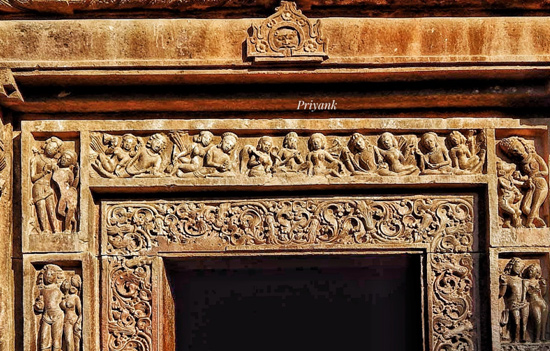 Kirtimukha at the premier position in the
famous Gupta temple, Nachna Kuthar, Panna.
Kirtimukha at the premier position in the
famous Gupta temple, Nachna Kuthar, Panna.
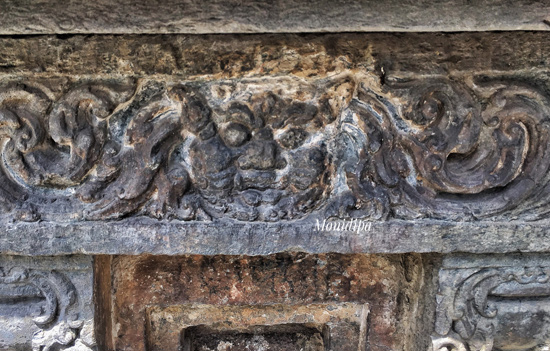 Kirtimukha on top panel of a temple wall niche, Baseswara temple, Bajoura, Kullu district.
Kirtimukha on top panel of a temple wall niche, Baseswara temple, Bajoura, Kullu district.
Kirtimukha is also known as Grasamukha (western India) or
Rahurmukha (eastern India). It also represents time or Kala. The word Grasa, which means to devour, can be seen at parity
with Rahu who devoured the sun and moon, symbolising the Solar and Lunar eclipses.
Kala is also a devourer, the greatest one, which devours everything at the end.
Thus, the three names frequently associated with the face of
the Kirtimukha are synonymous. The kirtimukha or the Face of Glory as we see
depicted on temples contains in it three parts: a Lion’s face, the head of Rahu
(also loosely referred to as dragon’s head, as some believe Rahu has the shape
of a serpent), and the head of Death (Kala). The Lion, which is the solar
animal, symbolises Yasas- tejas (Splendour) and the Destroyer of all evil.
As per the Upanishads/Vedanta, Paramveswara or the Supreme God is represented by the Lion; and we
see this in the Narasimha avtar, where the Lion is Vishnu - Narayana and Nara
is the body or jiva (the creature). It is also Vishnu Narayana who cuts off
Rahu’s head, and with this death gesture restores life to the Eternal, the
immortal Head, now released from the ties of the worldly body of strife and
deceit.
In the mask of the Kirtimukha, the breath that gives power
and splendor belongs to the simha mukha with its blazing eyes. Behind this
visible face is the sun or the Eye of the All (as per Rig Veda), where “behind
the Death’s head, the mask is inflated with breath, the outbreathing of the
Supreme which is and makes the world.” The triple horns, which are rays,
denote the three aspects of the Lion, Rahu, and Kal; and also represent the
three aspects of time - Past, Present and Future (Shiva’s trident).
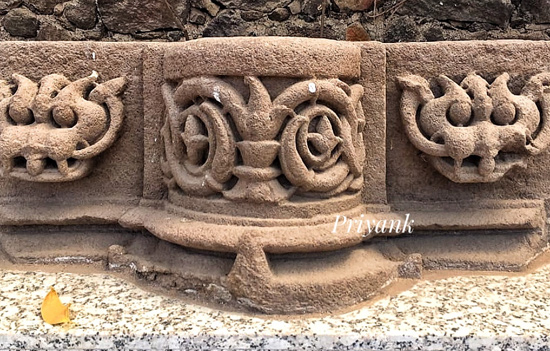 Daulatabd fort, kirtimukhas from one of the
destroyed temples of the Yadavas. Stalked lotus in the middle. This would have
been the threshold at the entrance of the temple sanctum.
Daulatabd fort, kirtimukhas from one of the
destroyed temples of the Yadavas. Stalked lotus in the middle. This would have
been the threshold at the entrance of the temple sanctum.
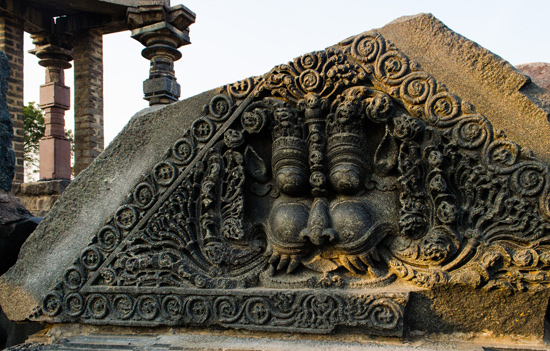 Kirtimukha, Warangal Fort.
Kirtimukha, Warangal Fort.
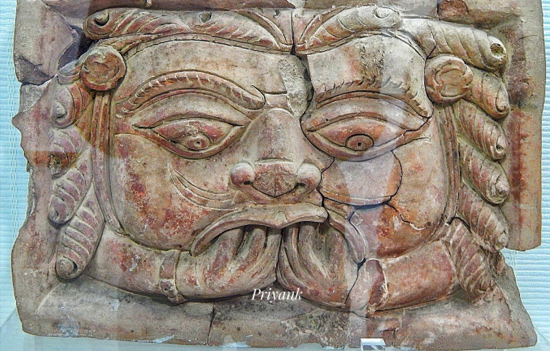 Terracotta plaque showing Kirtimukha, Nalanda.
Terracotta plaque showing Kirtimukha, Nalanda.
The three aspects of the Kirtimukha are –
1. It is the Death head of Kala or Time, the Devourer
or Grasa of Rahu;2. The Death’s head has in it the essence of Ahi Vrtra
(the Purusha) who himself holds splendor, all wealth, knowledge, and gods; who
has no hand or foot, is the source of solar power, and the creature that
envelopes the Universe and also emits it; and3. From the Lion’s open mouthed out-breathing Supreme
Brahman is emitted and sent out, thus giving life to the world.
Mahabharata (XXX.47.17) says that the 3 bodies of the Kirtimukha are also
that of the Shiva’s: Kala, Purusha, and Brahman.
The Kirtimukhas reveal that the world is a
result of the outbreathing of the Supreme Brahman, and this is shown as the
waves and curls that emerge out of the mouth. It moves along the curve and arch
of the gavaksha (which is an imagery depiction of the Sun and manifestation).
The breath moves around and often takes multiple shapes, such as foam of the
celestial waters, feathers of the sunbirds, flames (Agni was the first to
emerge from the Breath of heaven – RV. V. 45. I) and makara bodies.
Thus, the rhythmic pattern of the creepers
depict the movement of the breath, and is the symbol of Nature or Prakriti that
manifests itself as the curve of the gavaksha in which the rays of splendor
have their circumference. All the carvings and depictions seen along with Kirtimukha are imagery depiction or bringing forth to life the lines from Taittriya Aranyaka: “O waters whose steeds are the winds, whose lords are the rays of the sun, whose body is formed of shining rays… May the heavenly waters and herbs be auspicious to us and may they bring happiness…”
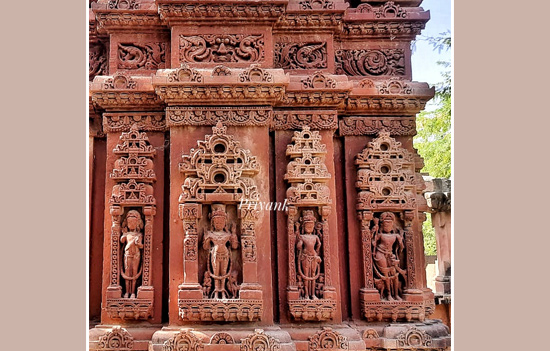 Kirtimukha above the gavaksha of the central niche, Jain Temple Osian.
Kirtimukha above the gavaksha of the central niche, Jain Temple Osian.
The various Puranic stories and other legends associated with kirtimukha
As per Skandapurana and Padmapurana,
just when Shiva was about to marry Parvati, Rahu as the messenger of Jalandhara
came asking for Parvati. Shiva in his anger produced a monstrous being from his
third eye that had the face of a lion with lolling tongue, standing hair, and
with eyes like lightning (looking like Narasimha), which rushed to kill Rahu;
however Shiva stopped it and instead ordered it to devour itself. This it did
as an act of self-sacrifice, leaving only the head, which is the Kirtimukha.
Thus, kirtimukha is a part of Shiva’s
Consciousness, where we find Shiva in his terrific aspect of Mahakaal sharing
the features of Kirtimukha as Kaal. Kirtimukha is also similar to the head of
Vishnu avtar of Narasimha.
The two Puranas (Skandapurana and Padmapurana)
further add that kirtimukhas must be seen at the entrance of temples dedicated
to Shiva, and they must be worshipped first before the devotee enters the
sanctum. That is why it is found on front of the threshold of the shrine, where
devotees sprinkle water on it and take care not to step on it.
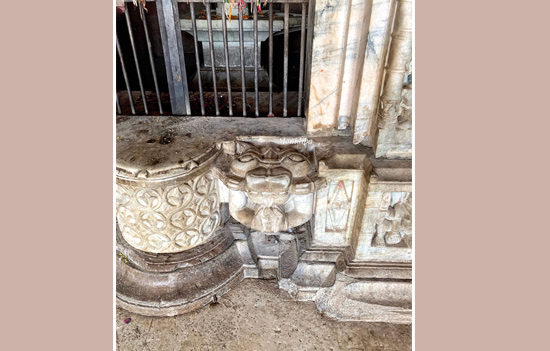 Kirtimukha or Simha mukha on front of the threshold of the Shiva shrine,
Someswara temple, Bhangarh fort.
Kirtimukha or Simha mukha on front of the threshold of the Shiva shrine,
Someswara temple, Bhangarh fort.
A Lingayat legend tells us that after killing Hiranyakasipu
(Simhika’s brother; hence Rahu’s uncle) Narsimha had turned arrogant. To stop
him for causing further destruction, Shiva killed Narasimha, and out of the
severed head of Narasimha, Shiva made the kirtimukha.
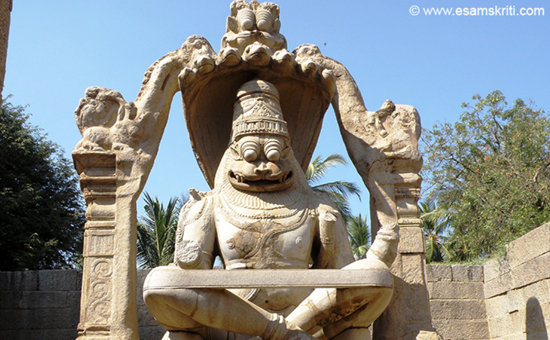 Kirtimukha above Narasimha showing similar
features. Kalikapurana tells us that Narayana is the
simha part in the Narasimha avtar.
Kirtimukha above Narasimha showing similar
features. Kalikapurana tells us that Narayana is the
simha part in the Narasimha avtar.
Reference
1. Stella Kramrisch, The Hindu temple.
To read all
articles by author
Author
studies life sciences, geography, art and international relationships. She
loves exploring and documenting Indic Heritage. Being a student of history she
likes to study the iconography behind various temple sculptures. She is a
well-known columnist - history and travel writer. Or read here
Article
was first published on author’s blog and here
Article and pictures are courtesy and copyright author.